Introduction
User stories and acceptance criteria play a crucial role in the software development process, ensuring that the end product meets user expectations and business objectives. By encapsulating user needs in a digestible format, user stories provide a clear roadmap for development teams. These stories, structured as "As a [user role], I want [feature] so that [reason]," prioritize the value delivered to the user.
User stories are complemented by use cases, which outline the interactions between actors and the system, specifying goals and scenarios that drive system behavior. These narratives guide the requirements analysis phase and ensure that design, implementation, and testing are guided by clear, user-focused objectives. The significance of user stories and use cases is echoed by industry experts, emphasizing their role in effectively communicating stakeholder requirements.
In agile development, user stories serve as a pivotal tool for understanding and documenting end-user needs. They promote collaboration and customer value, guiding teams in planning, estimating, and executing software increments. Acceptance criteria form the backbone of user story satisfaction, outlining the essential conditions that must be met to deem a feature complete.
These criteria are clear, testable, measurable, and vital for the product's acceptance. Crafting effective user stories and acceptance criteria requires attention to detail, clarity, and collaboration with stakeholders. By prioritizing user needs, incorporating acceptance criteria, and engaging stakeholders throughout the process, development teams can ensure the successful delivery of software that meets user expectations.
What is a User Story?
User stories are integral to the modern software development process, encapsulating the needs and goals of end users in a format that is both digestible and actionable for development teams. Adhering to a structure such as 'As a [user role], I want [feature] so that [reason],' these narratives focus on the value provided to the user, aligning the output with the core requirements. The significance of user stories is underpinned by their role in capturing the essence of use cases, which are foundational to understanding and documenting system requisites.
Use cases, defined by the OMG UML specification, outline the interactions between actors (users or other systems) and the system itself, specifying the goals and scenarios that drive system behavior. The creation of user stories is a pivotal step in the software development lifecycle, informing the requirements analysis phase and ensuring that the design, implementation, and testing phases are guided by clear, user-focused objectives. This approach not only streamlines communication but also ensures that the end product aligns with user expectations and business objectives.
The significance of user stories and use cases is echoed by industry experts Ivar Jacobson and Alistair Cockburn, who emphasize their continued relevance in providing clear and concise descriptions that effectively communicate stakeholder requirements, thereby solving a range of problems with a straightforward method.
Why Use User Stories in Agile Development
User stories in agile methodologies, such as Scrum and Kanban, serve as a pivotal tool for understanding and documenting the needs and expectations of the end-user. By encapsulating the desired functionality from the perspective of the user, these stories catalyze collaboration and ensure that customer value is at the forefront of the development process. They are instrumental in guiding teams to effectively plan, estimate, and execute software increments that fulfill user requirements.
At the heart of user stories lies the concept of use cases, which are vital for capturing the functional requirements of systems. This approach focuses on the interactions between actors—users of the system—and the system itself, delineating the main scenario for achieving the user's goals, as well as alternative paths and potential pitfalls. As per the Object Management Group's Unified Modeling Language (UML) specification, use cases define the objectives and outline the system's capabilities in relation to user interaction.
Agile's emphasis on early and continuous testing aligns closely with the practice of defining and refining use cases. The methodology's iterative nature allows for the flexibility to adapt and evolve these requirements throughout the project lifecycle. This contrasts with the previous 'waterfall' approaches, advocating for frequent iterations and collaboration, and welcoming changes even at advanced stages of the project.
Real-world application of these principles can be seen in enterprises such as M&T Bank, which, amid the digital transformation of the banking industry, has adopted Clean Code standards to ensure the maintainability and performance of its software, addressing quality and compliance needs. Agile's history, dating back to the personal computing shift of the late 1970s, demonstrates its enduring relevance in meeting rapidly changing customer requirements and its successful implementation in complex industries.
In conclusion, user stories and use cases are not just theoretical elements of software development; they are practical tools that have been utilized effectively in various industries to achieve clarity, maintain compliance, and deliver software that meets the high expectations of users. The continuous evolution and application of these agile practices underscore their significance in the dynamic field of software development.
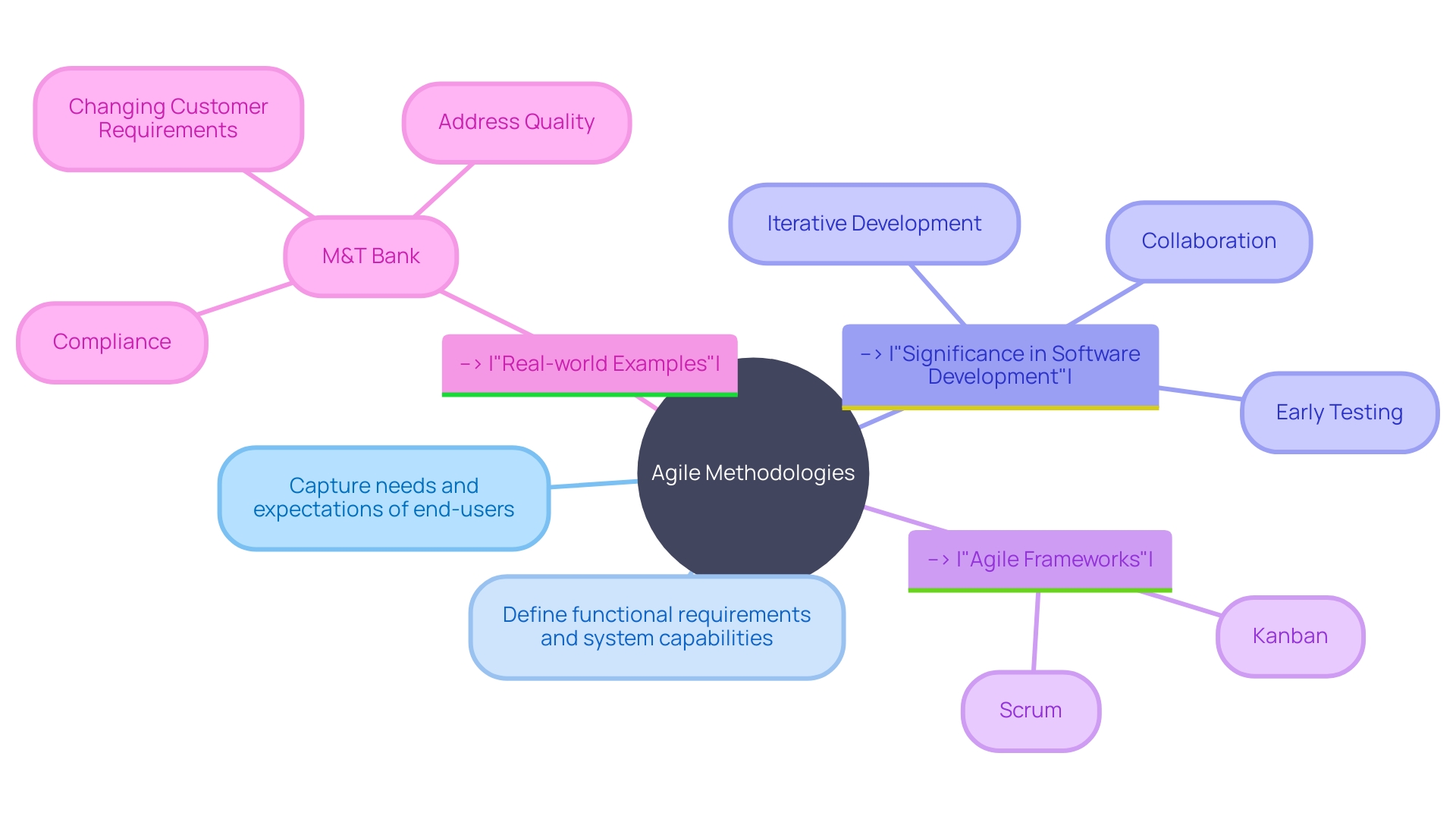
How to Write Effective User Stories
To craft compelling user stories, it's essential to encapsulate the essence of the requirement while ensuring clarity and brevity. Start by pinpointing the user role—this is about who will benefit from the feature. Next, crystallize the objective, delineating what the user aims to accomplish.
Incorporating acceptance criteria is crucial, as these are the benchmarks that signal completion.
Keep user stories succinct to maintain focus. Prioritize them to reflect their significance and the value they add to both users and the business. Engaging with stakeholders throughout the creation process fosters a mutual understanding, which is pivotal for the project's success.
Consider the proven solutions from the past, such as use cases, which remain relevant by defining system requirements through the lens of Actors, Use Cases, and subjects. This method, as defined by the Object Management Group (OMG) Unified Modeling Language (UML) specification, continues to be a robust way to communicate requirements.
In recent developments, the focus is shifting towards automated quality control, underscoring the importance of understanding not just the components of software but also their origins and the paths they've taken through the development lifecycle. A deeper comprehension of code progression, scans, tests, and deployment environments is gaining traction, providing a comprehensive view for remediation.
Effective user stories and acceptance criteria prevent misunderstandings, such as the unexpected development of a search bar feature instead of a category browsing interface in an online bookstore, ensuring the delivery of solutions that truly meet customer needs and achieve product-market fit. This method aligns with the current industry trend towards objective assessments in software development and the integration of security into all layers of the technology ecosystem.
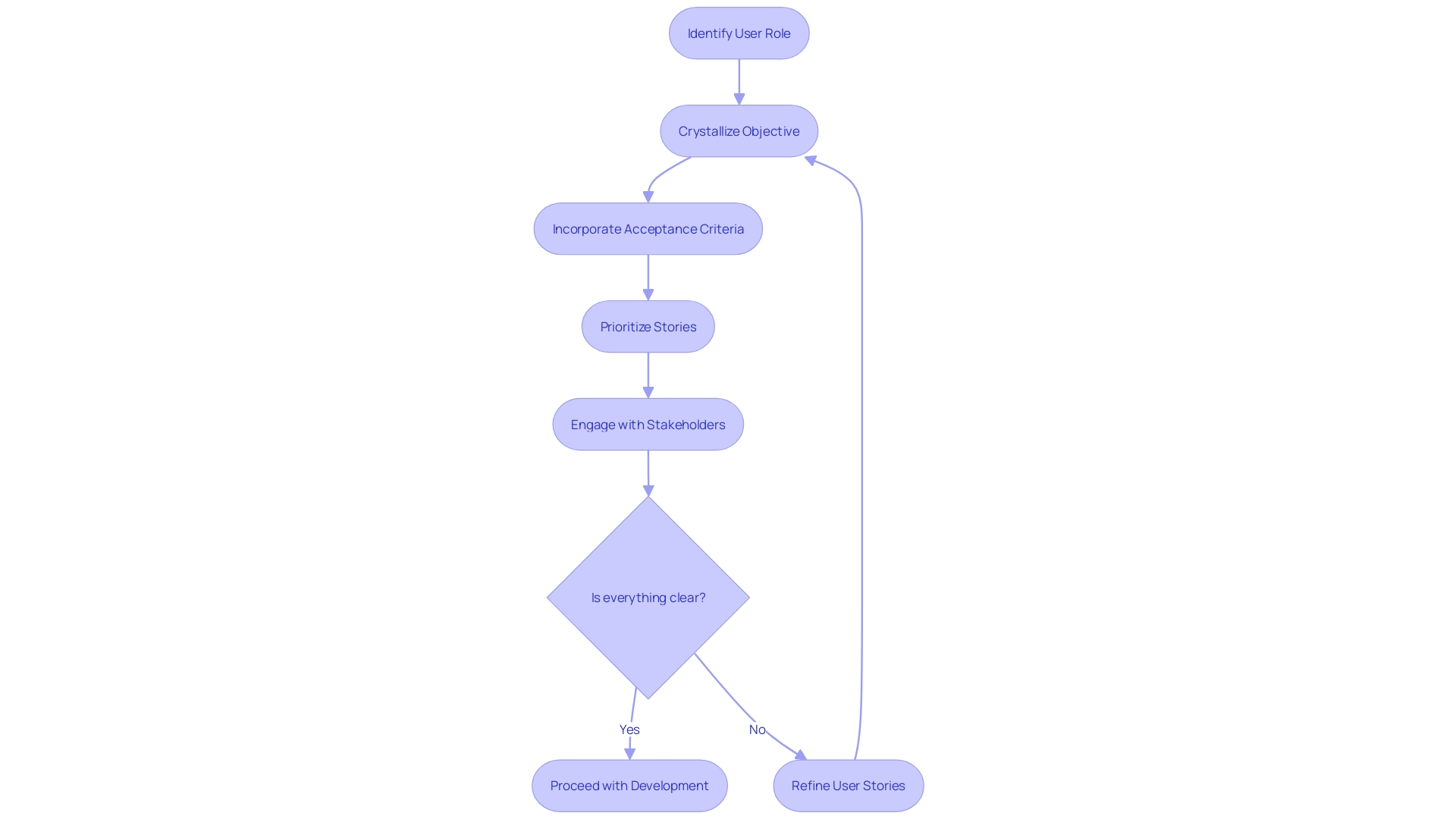
Understanding Acceptance Criteria
Acceptance criteria form the backbone of user story satisfaction, outlining the essential conditions that must be met to deem a feature complete. These benchmarks are not merely a checklist; they encapsulate operational, functional, or design constraints that are clear, testable, measurable, and vital for the product's acceptance. By defining these criteria, developers and stakeholders can ensure alignment and understand the specific behaviors that the feature or function is intended to exhibit.
This understanding is crucial, as every requirement originates from a real-world problem, with software development being a means to solve it. The Object Management Group's Unified Modeling Language (UML) standards reinforce the importance of clear requirements, emphasizing actors, use cases, and the system's subjects. In the agile methodology context, acceptance criteria are pivotal, facilitating rapid iterations and helping teams welcome changes, even in advanced project stages.
As the industry evolves with new challenges such as AI integration and shifting work environments, the clarity provided by well-defined acceptance criteria is more important than ever to navigate changes and maintain project momentum.
Purpose and Benefits of Acceptance Criteria
Acceptance criteria are essential for ensuring that a user story is clearly defined, aligning the vision between developers and stakeholders, and verifying that the software delivers the required outcomes. This precision in user stories is crucial, especially in sectors like banking, where digital transformation is paramount, and the cost of software issues can be immense. For instance, M&T Bank has leveraged Clean Code standards to uphold software quality in a rapidly evolving financial landscape.
Likewise, Agile methodologies emphasize the significance of iterative development and collaboration. Despite its challenges, Agile remains a robust framework for fostering efficiency and adapting to changes, as seen in the Agile Manifesto's principle that 'Working software is the primary measure of progress.' Accurate acceptance criteria contribute to this by refining communication, eliminating misunderstandings, and enhancing the software's overall quality.
They form a foundation for testable, measurable, and necessary requirements, as outlined by industry practices, to address real-world problems effectively.
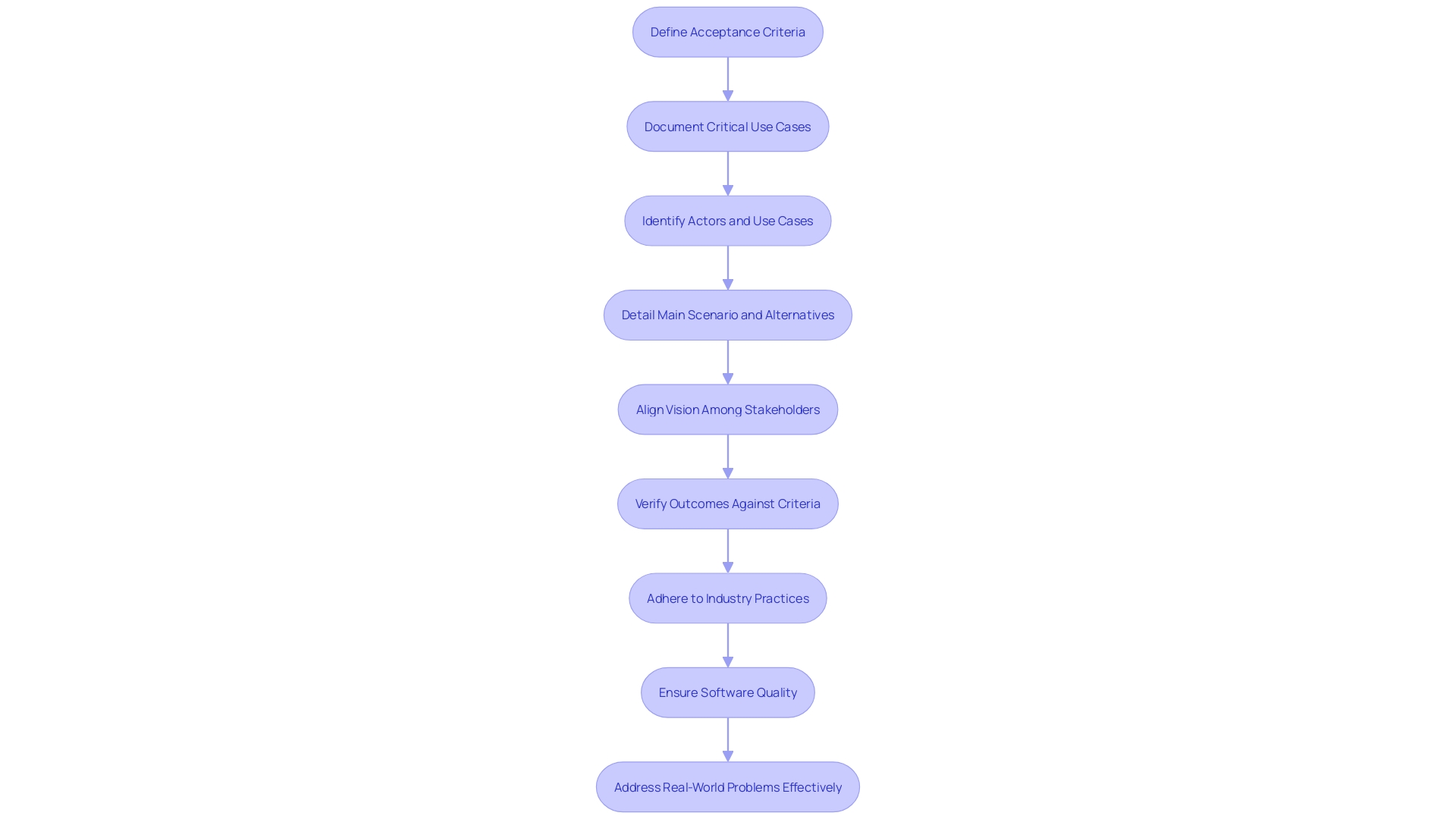
How to Write Acceptance Criteria
Crafting acceptance criteria for user stories necessitates a keen attention to detail and an understanding of the end goal. It's essential to articulate the behavior and outcomes desired with precision, ensuring that the criteria are actionable and verifiable. A robust approach involves the use of Gherkin language, as it embraces the BRIEF best practice—employing business language, real data, intention revealing, and essential information only.
Use case documentation is critical, as it represents the functional blueprint of the system. Embrace the UML-defined key concepts of Actors, Use Cases, and Subjects to delineate the various scenarios, both mainstream and alternative, that the system may encounter. This not only ensures coverage of a wide range of conditions but also serves to enhance communication with stakeholders about the system's requirements.
A comprehensive test case will include a unique identifier, a clear description, prerequisites, and detailed test steps. The objective is to validate each feature or functionality thoroughly. Remember, the art of writing acceptance criteria and test cases is not static; it evolves with the industry's rapid advancements, but the core principles remain timeless.
By engaging stakeholders in the crafting process, you validate expectations and drive clarity, laying down a pathway for successful software development and delivery.
Key Characteristics of Good Acceptance Criteria
User Acceptance Testing (UAT) is a critical phase in software development that ensures a system meets business requirements and is ready for use. It demands a set of well-defined criteria that guide testers to validate the functionality and performance of a system. These criteria should be:
- Specific, providing clear and concise details on what is to be tested. For instance, a user story must include specific actions and results to be validated.
- Measurable, with quantifiable benchmarks to determine if the criteria have been fulfilled. This could be in the form of test cases that have pass or fail outcomes.
- Achievable, meaning the set goals can be met with the available resources and current technology.
- Relevant, ensuring that each criterion directly relates to an important aspect of the system's functionality that users will engage with.
- Time-bound, with clear deadlines that align with project timelines, ensuring that testing is completed efficiently and without delay.
- Independent, allowing each criterion to be tested on its own without dependencies, making sure that they can be validated even if other parts of the system are not yet finalized.
In the dynamic landscape of software development, it's essential to balance thoroughness with the need to move quickly through the exploration and exploitation phases of a project. Taking on strategic technical debt during the exploration phase can be acceptable to accelerate the discovery of diverse solutions. However, when transitioning to exploitation, solidifying the best solution into a reliable product becomes paramount, and testing criteria must adapt to this shift.
Furthermore, documenting critical use cases for the products and services involved allows for a more comprehensive understanding of system requirements. This aligns with the concept that software quality is not just about meeting the specifications but also about satisfying end-user expectations and ensuring maintainability within time and budget constraints.
Performance evaluation is a necessary component for maintaining high standards throughout a product's lifecycle. It provides insights into a system's behavior, uncovers limitations, and identifies areas for improvement. Therefore, effective performance evaluation should be incorporated into the criteria to ensure a system not only meets initial acceptance but continues to perform optimally over time.
As the hiring landscape becomes increasingly competitive, with a higher bar for quality and a preference for candidates with relevant experience, it is vital for acceptance criteria to reflect the caliber of expertise expected within the industry. This ensures that any software developed meets the high standards that have become the norm in the field.
Difference Between Acceptance Criteria and Definition of Done
Understanding the nuances between acceptance criteria and the definition of done is pivotal for the seamless execution of software projects. Acceptance criteria serve as a detailed checklist for what must be delivered to meet the requirements of a particular user story. They are akin to a set of bespoke conditions that delineate the functionality and behavior of a feature, ensuring it aligns with the user's expectations and needs.
This specificity in acceptance criteria is a reflection of the articulated use cases, which capture the system's requirements, consisting of actors, use cases, and the system under consideration. It's a focused lens on the desired outcome for a singular aspect of the project, guiding developers and testers towards a clear goal for each user story implementation.
In contrast, the definition of done is the broader umbrella under which the project resides, providing a universal standard that applies to the project as a whole. It's an overarching set of criteria that marks the completion of work, from coding to testing, ensuring that each increment of the project adheres to the quality standards necessary for the product or service. This concept emphasizes the importance of a holistic view, ensuring that all components of the software are fully operational and meeting the predefined benchmarks before being considered complete.
The distinction between these two concepts is significant because it underscores the layered approach to ensuring quality in software development. While acceptance criteria focus on the granular details necessary for fulfilling specific user needs, the definition of done ensures that these needs are met within the context of the entire system's functionality and performance. This duality is reflective of the industry's shift towards simplifying processes to add value as early as possible, avoiding the pitfalls of overestimating and under-delivering that are often associated with fixed project scopes and deadlines.
Furthermore, the lack of clarity in defining these terms can lead to poorly-defined requirements, which are a common source of project overruns and maintenance challenges. Well-defined acceptance criteria and a clear definition of done are crucial for minimizing costly rework and ensuring that resources are optimized, echoing the sentiment that 'engineering is the art of doing that well with one dollar, which any bungler can do with two.' By embracing these concepts, development teams can avoid the excessive costs associated with iterative design changes that occur when construction precedes a complete design.
In essence, while acceptance criteria and the definition of done may share a symbiotic relationship, their roles within the software development lifecycle are distinct yet equally important. Together, they form the bedrock of a robust QA process, ensuring both the micro-level precision of individual user stories and the macro-level integrity of the entire project.
Involving the Team in Defining Acceptance Criteria
The creation of user acceptance criteria is a cornerstone in the development of reliable software, demanding a multifaceted approach that taps into the collective expertise of the development team, product owners, and additional stakeholders. Harnessing a range of perspectives not only clarifies the user story but also fosters a sense of engagement and ownership among the team. Such collaboration is instrumental in achieving a superior quality product that aligns with customer expectations.
Utilizing use cases is a powerful strategy for documenting the essential functions of your products or services. They serve as a blueprint for understanding system requirements, detailing the actions of various actors within the system and outlining both primary goals and alternative outcomes. This practice has stood the test of time in the software industry, offering a simple yet effective solution to perennial challenges by streamlining communication and setting clear expectations for all involved parties.
In the realm of software development, the notion of organizing work into projects often leads to the misconception that estimation of tasks is a necessity. However, this mindset can introduce unnecessary anxiety and even delay the delivery of value. A more effective approach is to focus on simplifying processes in order to provide value to users as swiftly as possible, bypassing the pitfalls of fixed release dates and the estimation quagmire.
A comprehensive plan for quality assurance (QA) is imperative, beginning with a clear definition of scope to determine the extent of test case automation and the selection of the most cost-effective and compatible tools. Establishing a robust testing framework supports this endeavor, complemented by careful configuration of the testing environment and meticulous preparation of test data. With innovation occurring at breakneck speed, QA teams must balance the demand for rapid release cycles with the imperative of maintaining software quality.
By employing modern testing methodologies, the perception of QA is shifting from a cost burden to a strategic investment that yields significant cost savings and ROI.
Ultimately, the effectiveness of user acceptance testing hinges on detailed and precise requirements. By thoroughly understanding the client's needs and objectives at the outset, the development process becomes more streamlined, minimizing the need for post-development fixes and revisions. This foresight not only enhances efficiency but also ensures that the software delivers on its promise to solve real-world problems.
Best Practices for Using Acceptance Criteria in Agile
Leveraging the power of acceptance criteria in Agile development is pivotal for creating software that's not only functional but also meets the highest quality standards. Here are some best practices for utilizing acceptance criteria effectively:
- Initiate Early: Incorporate acceptance criteria at the onset of project planning. This early integration lays the groundwork for clear objectives and a focused development path.
- Maintain Currentness: As projects evolve, so should the acceptance criteria. Regularly revising them ensures they reflect the current needs and goals of the project, keeping every team member on the same page.
- Basis for Testing: Use acceptance criteria as the foundation for crafting comprehensive test cases. This ensures that the software is validated against the precise requirements it's supposed to meet, leading to robust and reliable outcomes.
- Focus on Prioritization: Continuously evaluate and prioritize acceptance criteria to align with user needs and business objectives. This helps in concentrating efforts on features that deliver the most value.
- Collaborate and Communicate: Share acceptance criteria with all stakeholders to promote transparency and foster collaboration. This ensures everyone involved has a common understanding of what the software should achieve.
By documenting critical use cases, as outlined by the OMG UML specification, you're able to capture the essence of what the system is intended to do. This involves identifying the actors, use cases, and scenarios that will guide your testing process. A solid example of this practice in action is M&T Bank's approach to establishing Clean Code standards to maintain the performance and security of their software in response to the digital transformation of the banking industry.
Agile methodologies, epitomized by the Agile Manifesto, advocate for iterative development, continuous improvement, and adapting to change even in the late stages of a project. As the software development landscape evolves with new challenges, such as developer burnout and the integration of AI, these best practices for acceptance criteria remain more relevant than ever. They provide a structured yet flexible framework that supports Agile's core principles of rapid iteration and collaboration between developers and business executives.
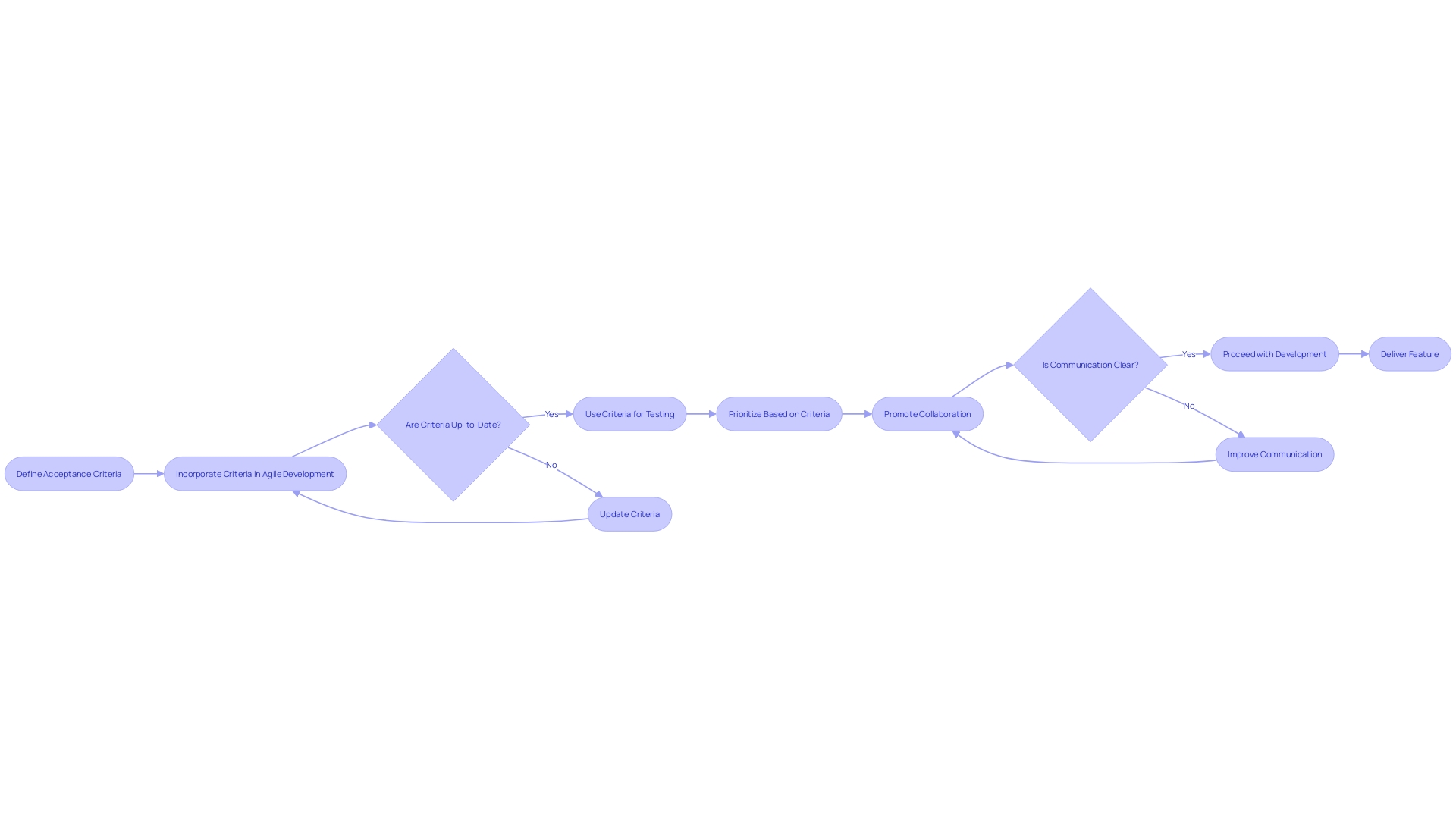
Examples of User Stories and Acceptance Criteria
Understanding user stories and acceptance criteria is vital for delivering software that meets user needs. Let's delve into some practical examples:
User Story 1: As a registered user, I need a way to reset my password to regain access to my account without hassle.
Acceptance Criteria:
- Presence of a 'Forgot Password' link on the login screen.
- Redirection to a password reset page after clicking the 'Forgot Password' link.
- Email delivery with a password reset link after submitting a registered email.
- Redirection to a new password creation page upon clicking the reset link.
- Automatic navigation to the login page post password reset completion.
User Story 2: As a customer, I want to add products to my shopping cart easily to facilitate my purchase process.
Acceptance Criteria:
- An 'Add to Cart' button is visibly placed on the product details page.
- Products are added to the shopping cart with a single click of the 'Add to Cart' button.
- The shopping cart clearly lists all added products, along with their quantities and prices.
- Options are available to modify product quantities or remove items within the shopping cart.
- A smooth transition to checkout enabling the completion of the purchase.
These scenarios not only specify the functionality but also emphasize the user's goal and the system's response, aligning with the Object Management Group's Unified Modeling Language (UML) definition of use cases. They reflect the system's requirements, focusing on the actors, use cases, and the system under consideration.
In the spirit of Dennis Austin's work on PowerPoint, software should provide a seamless and intuitive experience, where what users see during editing mirrors the final output. Similarly, user stories and acceptance criteria should lead to an interface that allows users to achieve their objectives efficiently, reinforcing the critical role of well-defined requirements in software development.
By documenting these use cases, software development teams can avoid the pitfalls of poorly-defined requirements, ensuring that the final product aligns with user needs and expectations, as emphasized by industry experts Ivar Jacobson and Alistair Cockburn. This approach to capturing system requirements continues to prove effective in delivering robust software solutions.
Common Pitfalls and How to Avoid Them
Ensuring that acceptance criteria are specific, detailed, and encompass all necessary conditions is paramount to avoid vague or incomplete guidelines. These criteria serve as a definitive checklist that guarantees accurate implementation and prevents misunderstandings. Collaboration and communication should not be an afterthought but rather a core strategy in defining these criteria.
Regular interactions and feedback sessions are essential to uncover any discrepancies or omissions.
To maintain the usefulness of acceptance criteria, they must be concise and targeted, avoiding the temptation to include extraneous details that could muddle implementation and testing. Remember that user stories are fluid; they adapt and grow with the project. Consequently, acceptance criteria should be reviewed and revised continuously to align with any project evolutions or newfound insights.
Documentation is the cornerstone of traceability in user stories. It ensures that acceptance criteria are linked to their respective user stories, providing a clear trail of progress and a comprehensive understanding of the requirements.
The practice of documenting critical use cases is a testament to this, as it allows stakeholders to effectively utilize the system information. As the Object Management Group's Unified Modeling Language specification outlines, use cases are instrumental in capturing system requirements, highlighting key concepts such as actors, use cases, and the system under consideration. A well-articulated use case describes the interactions needed to achieve a goal, along with alternative paths and potential pitfalls.
In the rapidly evolving software industry, where Agile methodologies promote rapid iterations and the welcoming of late-stage changes, the significance of well-defined acceptance criteria and user stories cannot be overstated. Despite technological advancements and the allure of new tools, the simplicity and effectiveness of use cases remain a reliable solution to perennial challenges.
A test case, as a set of conditions or variables, is an indispensable tool for testers to verify the functionality of a software application. It guides testers through inputs, execution conditions, and expected outcomes, ensuring the software performs as intended across various scenarios.
Amidst the changing landscapes of software development, the emphasis on working software as a measure of progress, a principle of the Agile Manifesto, underscores the importance of tangible results over theoretical planning. Therefore, establishing clear, well-documented acceptance criteria in line with use cases and test cases is not just a best practice but a necessity for successful software development.
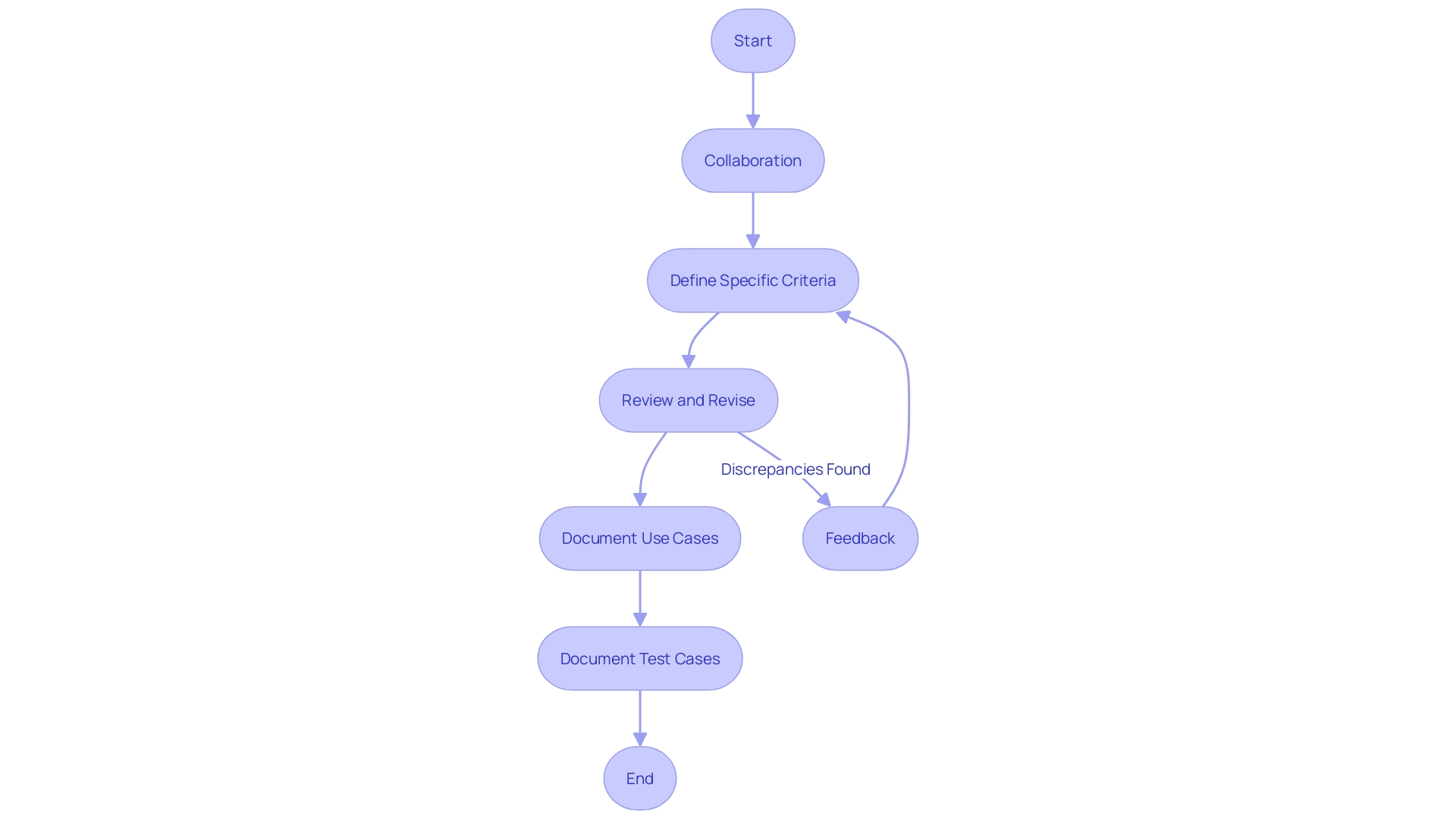
Conclusion
User stories and acceptance criteria are essential for successful software development. By encapsulating user needs and prioritizing value, user stories provide a clear roadmap for development teams. Complemented by use cases, they guide requirements analysis and ensure user-focused objectives.
In agile development, user stories promote collaboration and customer value, guiding planning, estimating, and execution. Acceptance criteria are vital for feature completion, outlining clear and testable conditions.
Crafting effective user stories and acceptance criteria requires attention to detail, clarity, and collaboration with stakeholders. Prioritizing user needs, incorporating acceptance criteria, and engaging stakeholders throughout the process ensure successful software delivery.
The distinction between acceptance criteria and the definition of done is significant. Acceptance criteria focus on specific user needs, while the definition of done ensures overall system functionality. Both are crucial for quality software development.
Involving the team in defining acceptance criteria fosters ownership and engagement. Utilizing use cases and embracing Agile methodologies are best practices for effective acceptance criteria. Documenting critical use cases helps avoid poorly-defined requirements.
In conclusion, user stories and acceptance criteria are practical tools for delivering software that meets user expectations. By following best practices and involving stakeholders, development teams can ensure successful software delivery.





